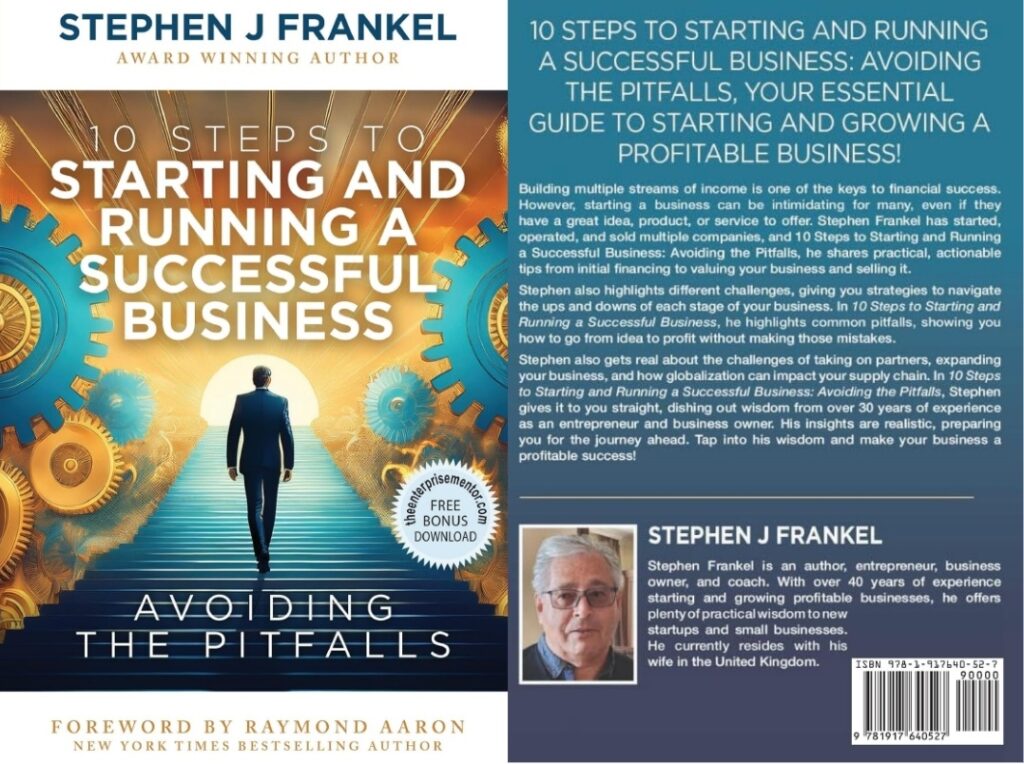The Honest Truth About Building A Business That Actually Lasts

Every year, countless new businesses are born with excitement and hope, only for many to vanish before their second anniversary. Stephen J. Frankel, in his book 10 Steps to Starting and Running a Successful Business: Avoiding the Pitfalls, explains why. His message is simple: enthusiasm is not enough. Strategy, financial wisdom, and the ability to learn from mistakes separate survival from collapse. His experience across different industries—sometimes thriving, sometimes struggling—gives this book a voice that is both cautionary and encouraging. For beginners who want real guidance, this is not a motivational poster but a working map.
Learning How To Test An Idea Early
Ideas are easy to dream up, but Frankel explains that testing them separates reality from fantasy. Many dive into business because they love a concept, but when the bills arrive, they realize there is no paying market. He shares examples of entrepreneurs who skipped the testing stage and paid the price with drained savings. His advice? Try out your idea in small ways before burning bridges. Sell part-time, gauge interest, or run limited trials. That early testing keeps dreams alive while protecting your financial foundation.
Understanding Why Financial Cushion Matters Most
A recurring theme in the book is money. Frankel pulls no punches—if you leap into business without financial preparation, you risk losing more than you gain. He advises setting aside at least six to twelve months of living expenses before going full-time. That cushion buys time, giving space for growth instead of panic. Without it, founders may quit too soon or bury themselves in debt. Crowdfunding and part-time work may help, but discipline and planning matter most. Business is not built on hope alone; it needs numbers that work.
Building Customers Through Service And Trust First
Marketing, Frankel reminds us, has changed, but its heart has not. Customers still buy from people they trust. A shiny ad may catch attention, but loyalty comes from relationships. He suggests entrepreneurs start close to home—networking events, community groups, or exhibitions—where conversations matter more than flashy campaigns. On a larger scale, SEO, paid ads, and online content expand reach. Yet the rule stays consistent: a good reputation brings referrals, and referrals are gold. Service that exceeds expectation turns one buyer into many.
Knowing The Real Costs Of Global Sourcing
When sales begin, the pressure shifts to delivery. A broken supply chain can damage a reputation beyond repair. Frankel dives into the realities of sourcing overseas. While manufacturing in China or India can appear cheaper, hidden costs—tariffs, shipping, delays, and import rules—often erase savings. Worse, one political shift or global crisis can leave orders stuck for months. His advice is practical: research every cost, know the paperwork, and work with trusted freight partners. Most importantly, always have backup suppliers. Customers rarely forgive missed promises.
Using Outsourcing As A Smart First Step
In the early stages, resources are thin, and every hire adds weight. Frankel shows how outsourcing bridges the gap. Bookkeeping, logistics, HR, or even answering services can be handled by agencies at a fraction of full-time costs. This keeps the founder’s energy on strategy instead of small tasks. Yet he cautions against over-relying. Outsourcing is a stepping stone, not a permanent escape. The goal is to free up time to grow until you can build a core team. Used wisely, it can mean the difference between stagnation and progress.
Recognizing That Not All Growth Is Success

Many new business owners equate expansion with achievement. Bigger office, more staff, multiple locations—it looks impressive from the outside. But Frankel exposes the trap. Expansion too early raises costs, increases complexity, and often breaks a company that was otherwise stable. He urges owners to ask hard questions: Are profits steady? Are systems strong enough to handle growth? Does customer demand justify it? Only when the answer is yes should expansion be on the table. Growth that isn’t grounded in numbers is more dangerous than no growth at all.
Facing The Reality Of An Exit Strategy
It may feel uncomfortable to think about leaving before you even start, but Frankel insists on it. Every business ends, whether by choice or by force. Planning for an exit from day one shapes decisions wisely. Whether you want to sell, pass down, or close with profit, clarity now prevents regret later. He explains how valuation, stability, and timing affect what you walk away with. The point is not to cling forever, but to leave well, with dignity and gain, not loss.
Accepting That Mistakes Are Part Of The Journey
One of the most refreshing parts of the book is Frankel’s honesty about failure. He does not pretend every business he touched was a success. Some failed, some thrived, some were sold. Instead of shame, he treats mistakes as education. He shares them openly so readers can avoid the same traps. That tone turns the book from a manual into mentorship. It reminds beginners that missteps are not the end—they are lessons that strengthen your next move.
Why This Guide Feels Real And Reliable
What makes 10 Steps to Starting and Running a Successful Business: Avoiding the Pitfalls different is its balance of caution and encouragement. It does not promise instant wealth, nor does it discourage ambition. Instead, it shines a light on the common traps that end businesses too soon and offers ways to step around them. Beginners will find reassurance in the simple, straightforward advice, while experienced entrepreneurs may recognize their own mistakes in its pages. Either way, it delivers something rare in business books: the honest truth about what it really takes to last.



